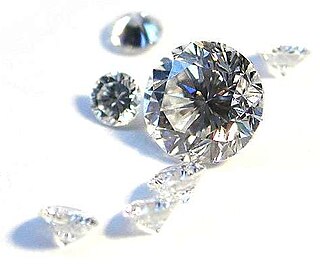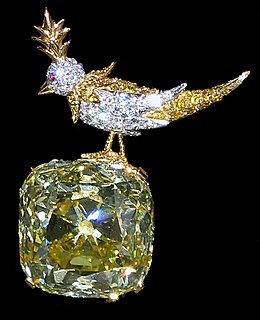
The Hope Diamond is a 45.52-carat (9.104 g) diamond originally extracted in the 17th century from the Kollur Mine in Guntur, India. It is blue in color due to trace amounts of boron. Its exceptional size has revealed new information about the formation of diamonds.

A chemically pure and structurally perfect diamond is perfectly transparent with no hue, or color. However, in reality almost no gem-sized natural diamonds are absolutely perfect. The color of a diamond may be affected by chemical impurities and/or structural defects in the crystal lattice. Depending on the hue and intensity of a diamond's coloration, a diamond's color can either detract from or enhance its value. For example, most white diamonds are discounted in price when more yellow hue is detectable, while intense pink diamonds or blue diamonds can be dramatically more valuable. Of all colored diamonds, red diamonds are the rarest. The Aurora Pyramid of Hope displays a spectacular array of naturally colored diamonds, including red diamonds.
The Heart of Eternity is a diamond measuring 27.64 carats, rated in color as "Fancy Vivid Blue" by the Gemological Institute of America. The Heart of Eternity was cut by the Steinmetz Group, who owned the diamond before selling it to the De Beers Group.
The Moussaieff Red Diamond is a diamond measuring 5.11 carats with a triangular brilliant cut, rated in color as Fancy Red by the Gemological Institute of America. It is the world's largest known red diamond, the rarest of them all.
The Ocean Dream is a diamond measuring 5.51 carats, rated in color as Fancy Deep Blue-Green by the Gemological Institute of America. The Ocean Dream is the first and one of the only natural diamonds known to the GIA to possess a blue-green hue, making it one of the rarest diamonds in the world. (A blue-green colour is commonly seen in artificially enhanced diamonds, whose colour is imparted by various irradiation methods. The Ocean Dream originated in Central Africa, and is currently owned by the Cora Diamond Corporation.
The Pink Star, formerly known as the Steinmetz Pink, is a diamond weighing 59.60 carat, rated in color as Fancy Vivid Pink by the Gemological Institute of America. The Pink Star was mined by De Beers in 1999 in South Africa, and weighed 132.5 carat in the rough. The Pink Star is the largest known diamond having been rated Vivid Pink. As a result of this exceptional rarity, the Beny Steinmetz Group called Steinmetz Diamonds took a cautious 20 months to cut the Pink. It was unveiled in Monaco on 29 May 2003 in a public ceremony.
The Pumpkin Diamond is a diamond weighing 5.54 carats rated in color as Fancy Vivid Orange by the Gemological Institute of America. While this may seem small when compared to other famous diamonds, the Pumpkin Diamond is, in fact, one of the largest Fancy Vivid Oranges the GIA reports having rated and is unique compared to other orange diamonds because it is light-colored and notably intense. The Pumpkin Diamond was mined in Central African Republic and then imported into South Africa for sale, it was later cut and polished by William Goldberg, and put to auction at Sotheby's where it was bought by Ronald Winston of the House of Harry Winston for the price of $1.3 million. It is currently estimated to be valued at $3 million.
The Great Chrysanthemum Diamond is a famous diamond measuring 104.15 carats with a pear-shaped modified brilliant cut, rated in colour as Fancy Orange-Brown and I1 clarity by the Gemological Institute of America. The Great Chrysanthemum is roughly the same size as the re-cut Kohinoor and almost three times the size of the Hope Diamond, The Great Chrysanthemum has the dimensions of 39.10 x 24.98 x 16.00 mm. and features 67 facets on the crown, 57 facets on the pavilion and 65 vertical facets along the girdle. The diamond, designed as a pendant, became the central focus of a necklace with 410 oval, pear-shaped, round and marquis diamonds.

The Logan Sapphire is a 422.98-carat (84.596 g) sapphire from Sri Lanka. One of the largest blue faceted sapphires in the world, it was owned by Sir Victor Sassoon and then purchased by M. Robert Guggenheim as a gift for his wife, Rebecca Pollard Guggenheim, who gifted the sapphire to the Smithsonian Institution in 1960. The sapphire's name is derived from Rebecca's new surname after she later married John A. Logan. It has been on display in the National Gem Collection of the National Museum of Natural History in Washington, D.C., since 1971. It is a mixed cushion-cut sapphire, approximately the size of a large chicken egg, and set in a silver and gold brooch surrounded by 20 round brilliant cut diamonds.

Harry Winston was an American jeweler. He donated the Hope Diamond to the Smithsonian Institution in 1958 after owning it for a decade. He also traded the Portuguese Diamond to the Smithsonian in 1963 in exchange for 3,800 carats of small diamonds.
Alfred E. Allnatt, known professionally as Major A.E. Allnatt, was an English businessman and art collector. He took over his father's supply business and developed it into Allnatt London Properties and other well-known businesses in England.

The Tiffany Yellow Diamond is one of the largest yellow diamonds ever discovered. Its carat weight was originally 287.42 carats in the rough when discovered in 1878 in the Kimberley mine in South Africa. It was cut into a cushion shape of 128.54 carats with 82 facets—24 more than a traditional round brilliant—to maximize its brilliance. The facet pattern features eight needle-like facets pointing outward from the culet (bottom) facet. Jewelry and diamond historian Herbert Tillander refers to this as a "stellar brilliant cut", and lists the gem in his book, Diamond Cuts in Historic Jewelry – 1381 to 1910 (1995), among other such diamonds: the Cullinan Diamond, the Koh-i-Noor, the Polar Star, the Wittelsbach, and others.

Diamond is one of the best-known and most sought-after gemstones. They have been used as decorative items since ancient times.
Graff is a British multinational jeweller based in London. It was founded by British jeweller Laurence Graff in 1960. A vertically integrated company, Graff operations comprise the design, manufacture and retail distribution of jewellery and watches.

The Bismarck Sapphire Necklace is a sapphire necklace designed by Cartier, Inc. in 1935. As of 2010, the necklace is on display between the Hall Sapphire and Diamond Necklace and the Logan Sapphire in the Janet Annenberg Hooker Hall of Geology, Gems, and Minerals at the Smithsonian Institution's National Museum of Natural History in Washington D.C., United States. It is named after Countess Mona von Bismarck, who donated the piece to the Smithsonian in 1967. The sapphire itself was mined in Burma, and was purchased by the Countess in Sri Lanka in 1926 during her honeymoon with Harrison Williams.

The Patiala Necklace was a necklace designed & made by the Cartier S.A. in 1928. It was made for Bhupinder Singh of Patiala, who was the Maharaja of the princely state of Patiala.
The Princie Diamond is an approximately 34.65 carat cushion-cut fancy intense pink diamond discovered 300 years ago in the Golconda mines. Christie's say that the Princie Diamond is believed to be the fourth largest pink diamond in the world, after the Daria-i-Noor, the Noor-ol-Ain - which are both part of the Iranian Crown Jewels; both were cut, according to experts, from one single c. 242 carat pink diamond, - and the Pink Star, a diamond weighing 59.60 carats.

The Ocean Paradise is a diamond measuring 1.6 carats after polish and was discovered in Brazil and currently owned by the Nahshonov Group. When discovered, it measured 6.43 carats. The Ocean Paradise is the second and one of the only natural diamonds known to the GIA to possess a blue-green hue, making it one of the rarest diamonds in the world.

A red diamond is a diamond which displays red colour and exhibits the same mineral properties as colourless diamonds. Red diamonds are commonly known as the most expensive and the rarest diamond colour in the world, even more so than pink or blue diamonds, as very few red diamonds have been found. Red diamonds, just like pink diamonds, are greatly debated as to the source of their colour, but the gemological community most commonly attributes both colours to gliding atoms in the diamond's structure as it undergoes enormous pressure during its formation. Red diamonds are among the 12 colours of fancy colour diamonds, and have the most expensive price per carat. They will typically run in the hundreds of thousands of dollars per carat range. Since they are the rarest colour, it is difficult to find them in large sizes, and they are mostly found in sizes less than 1 carat. Red diamonds only exist with one colour intensity, Fancy, although their clarities can range from Flawless to Included, just like white diamonds. The largest and most flawless red diamond is the 5.11 carat Fancy Red Moussaieff Red Diamond, which has internally flawless clarity.
The Red Cross Diamond is a canary-yellow 205.07-carat, cushion-shaped cut diamond which is among the largest known cut diamonds. The diamond was auctioned off in 1918 to support the British Red Cross Society. It has a Maltese cross visible in the diamond.









